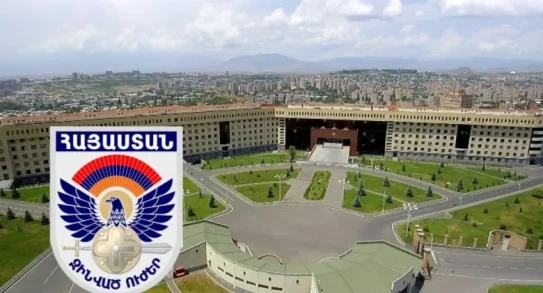The "Fact" daily writes:
As a rule, the country's foreign trade dynamics are considered to be one of the main economic and competitiveness indicators, but now there is still unhealthy trends in this regard, which is mainly due to the problems in the field of export. The statistical data of August revealed negative shocking developments in the exports when exports reached 40.8 percent, showing a sharp deterioration of the 15.3 percent decline in the previous month.
The analysis of the Luys Foundation also shows that these figures are not just a statistical abstraction, but reflect more deep system problems that have accumulated over the years and are now manifested by all their severity. Over the past few months, the dynamics of exports showed certain fluctuations, sometimes it seemed to be statements about gradual improvements, and the accumulative indicators showed a sign of relevant. These improvements, no matter how restrained, they would have to hope that the economy may find its balance of its balance and began to recover after major shocks of previous years. However, the sharp decline in August crumbled that restrained optimism and showed that the situation in exports was much more vulnerable than the last months of last months were more temporary fluctuations than signs of real economic growth.
However, the accumulative indicators continued to improve, but they did it in a significantly slower pace, only one percentage point, while the corresponding month of the previous month was 3.5 percentage points. This sharp slowdown is a clear signal that the problems in the export of exports are not only not solved, but also deepening, creating preconditions for the systemic crisis.
The structural export analysis reveals the complex and multi-layered nature of the problem. The study of the data on January-July shows that the decline in exports is mostly focused on one specific product group, which is conventionally called "expensive and semi-precious stones, and things", which actually reflects gold re-export operations.
Exports of this product group have been a huge amount of 75.7%, and its contribution to the decline in total exports was 52.1 percentage points. These figures show that Armenia's exports have largely dependent on gold re-exporting, which, of course, could not be a reliable support for stable and long-term development.
When this artificial source is exhausted or decreases, the real economy potential is revealed, which is painfully weak and not developed. However, the problem is not limited to the sharp decrease in gold re-export. A number of other important products also have significant negative contribution to the general export fall.
For example, the reduction in the export of cars, equipment and mechanisms also testifies to the weakening of the infrastructure and industrial potential, and the decline in export of goods and non-precious metals and the export of them indicates the problems of the production sector. The overall negative contribution of these goods books was about 1.2 percentage points, which inferior to the impact of gold re-exposure, is significant and testifies to the narrowing of the export base.
At the same time, it is necessary to notice that certain products have shown positive dynamics, but their role remains limited in the general picture. For example, the finished food product product group showed a 30.6% growth, which has contributed to the increase in total exports by 1.7 percentage points. This, of course, is a positive development and testifies to the ability of food production and processing, to find its place in foreign markets and stay competitive.
The growth of exports of plant origin products and devices and devices also contributed positively to 0.5 percentage points. However, no matter how encouraging, these positive trends cannot compensate for the decline in major exports and are not enough to change the overall picture.
The benefits of other products have been small for exports. The adjusted export analysis, when we neutralize the extent of the promotion of "expensive and semi-precious stones, precious metals and items". In this case, export growth is only 2.5 percent, which is a low indicator of any criteria and is especially worrying, taking into account the database effect.
The database effect, which should usually provide more significant growth compared to the low indicators of previous years, does not work, which clearly indicates the weakness of the real export potential. In other words, the country's exporters cannot use even statistical opportunities, which are given in the presence of a low comparison base.
This image not only describes the challenges of this year, but also proves the fact of the systematic loss of potential exports in recent years. The loss of the potential of export is a complex phenomenon, which is due to a number of interconnected factors. First of all, it reflects the weakening of the country's production base and the lack of modernization.
In recent years, Armenia has not been able to develop new exports that could replace old and consumed branches and did not invest enough resources in modernization and technological modernization and diversification. As a result, the country remains depending on a limited number of product groups, many of which are either raw material, or artificial, such as gold re-export. In some way, the loss of potential exports is also due to the weakening of competitive advantages in foreign markets. In many cases, Armenian goods are unable to compete with both price and quality, which leads to a reduction in the loss of the market department and the volume of exports.
The instability of economic policy and the lack of predictability plays an important role in the weakness of the export sector, which hinders long-term investment and strategic export development programs.
The lack of market diversification is also a significant problem. Armenia's exports are mainly focused on a limited number of countries and markets, which creates additional vulnerability to geopolitical and geopolitical shocks.
When economic difficulties or political tensions take place in one or more major imports, it immediately affects Armenian exports. The inability to open new markets and the difficulties of maintaining competitiveness in existing markets testify to the lack of strategic approaches at the level of marketing and commercial policy.
The issue of financing access to the restriction of export development also plays a significant role. Small and medium-sized exporters in Armenia often face difficulties working capital and investment financing. All this plus high interest rates of bank loans, the strict requirements of collateral and short terms of credit, make it difficult for exporters to access new markets when significant investments are needed.
Arthur Karapetyan


























